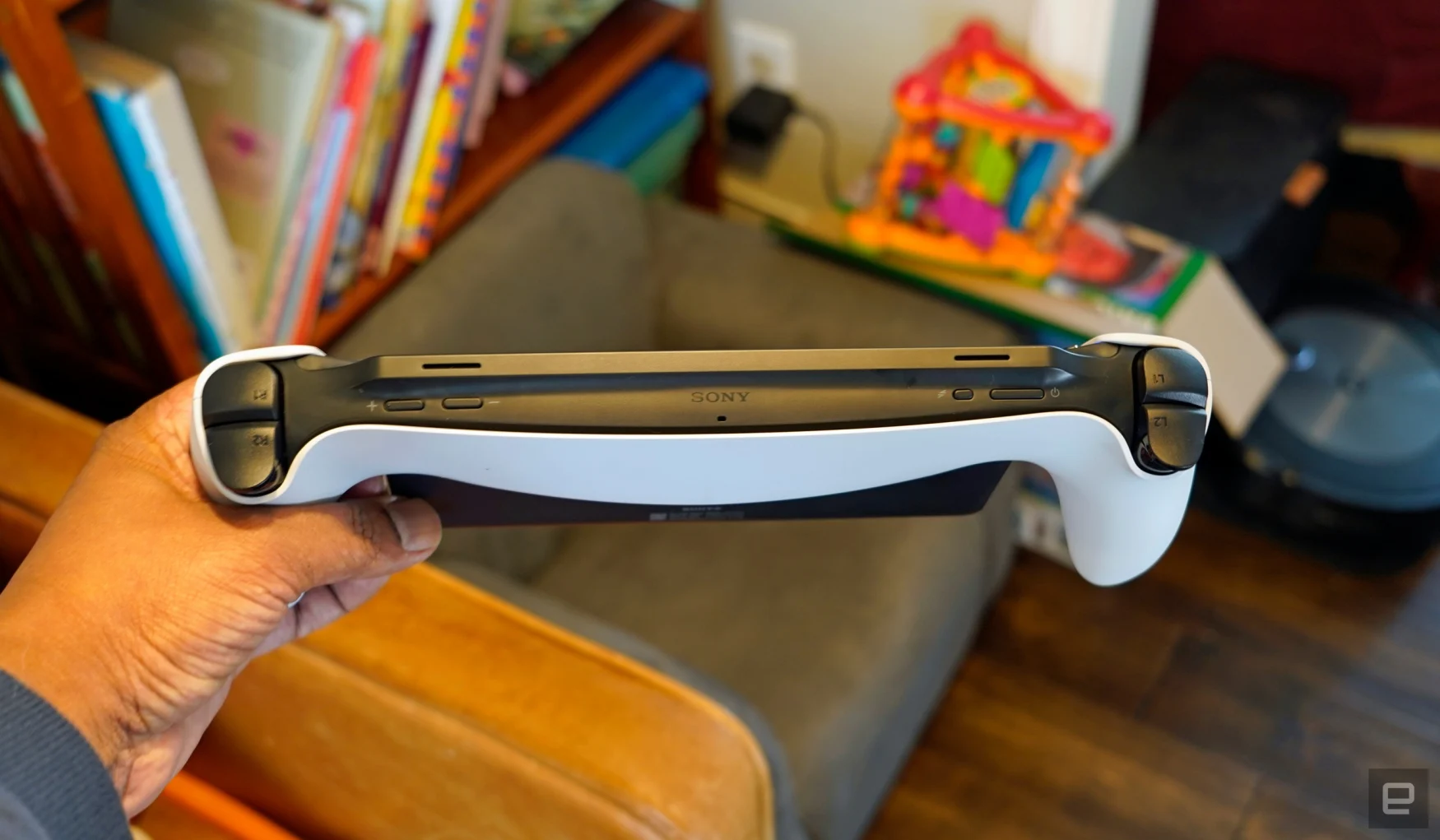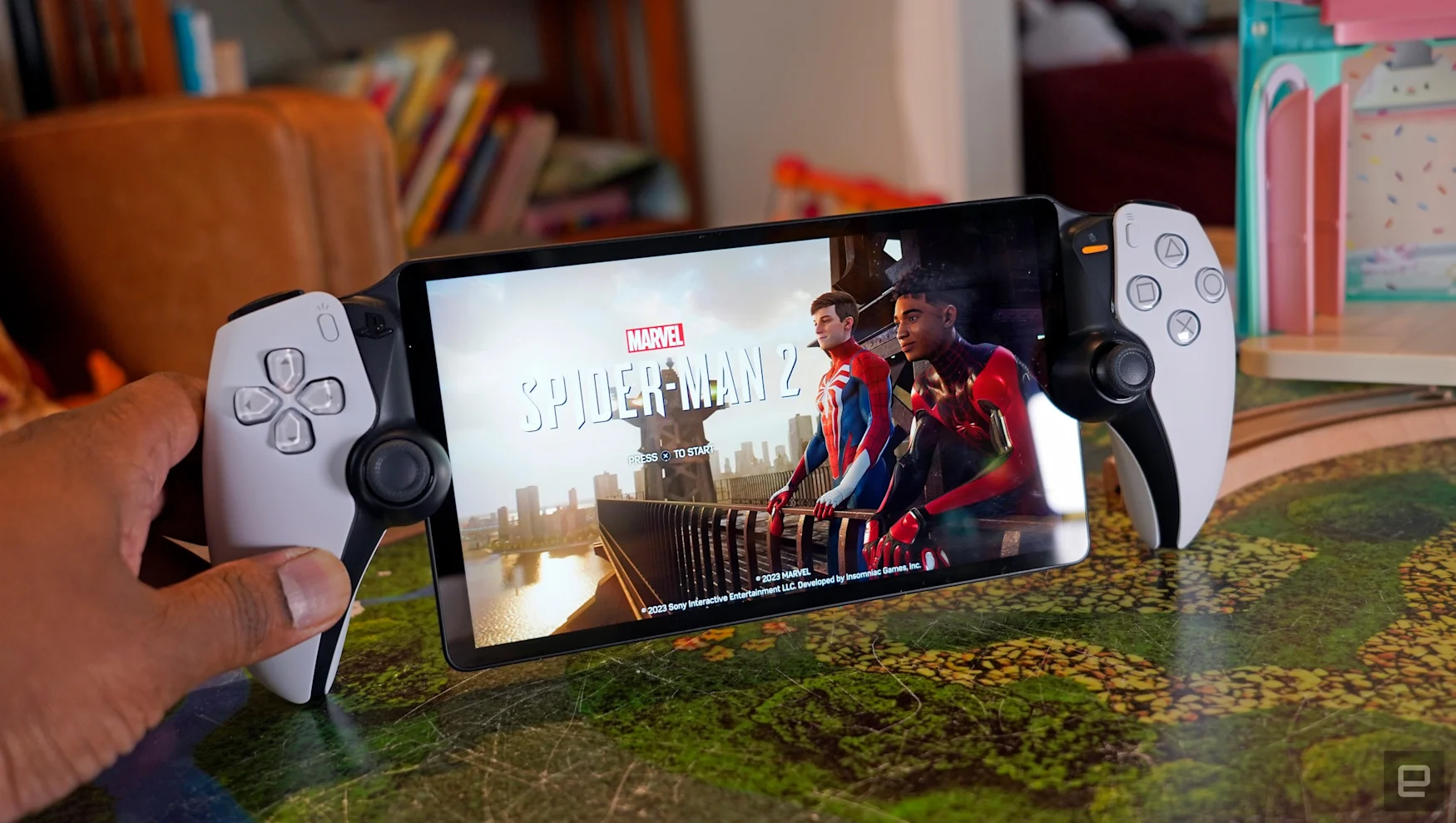PlayStation Portal review: A baffling handheld for no one but Sony diehards
What’s confusing, though, is that I have pretty great internet throughout my home. I’m using AT&T’s gigabit service with a modern Wi-Fi 6 gateway on my first floor, and there’s a mesh extension for my office in the basement. I typically see full wireless reception on my main floor, with speeds between 600 and 800Mbps on most devices. So why was the PlayStation Portal having such a rough time? I have no clue. My PS5, which sits in the basement, isn’t connected via Ethernet. But I also see 500Mbps speeds down there, so it didn’t seem necessary. During breakfast, I was sitting about 20 unobstructed feet from my router, so there wasn’t much physical interference either.
When I moved to my living room later in the day, which is also where my router sits, the Portal was able to connect to my PS5 in around 15 seconds. I spun up Spider-Man 2 and crossed my fingers. For whatever reason, it loaded up just fine and I was able to play for an hour with my daughter curled up beside me. That was the first time I could actually see the potential of this thing. My daughter and I have been gaming together a lot, but only with portable systems we can use together in bed or on the couch. It would take a lot more effort to bring her into my basement home theater, and frankly, she’d probably be bored there.
Photo by Devindra Hardawar/Engadget
So there we were, swinging through NYC streets as Peter Parker and Miles Morales, and it felt like magic. Spider-Man 2 appeared to be running at 60fps on the Portal in performance mode, and it was perfectly fine. Colors certainly didn’t pop as they do on my Switch OLED, and it couldn’t hold a candle to the Steam Deck’s new 90Hz OLED HDR screen, but it was still decently immersive without many video artifacts. The controls felt just as responsive as the DualSense, and its haptic rumble felt powerful and nuanced (certainly more so than the Switch or Steam Deck).
Moving up to my bedroom later in the day (one floor above the router, two floors above the basement) we were able to clock another 30 minutes in Spider-Man 2 with only occasional hiccups. Thankfully, the game automatically paused in those instances, similar to what you’d see if your DualSense controller lost power during normal gameplay. Every time we disconnected, I couldn’t help but look over at the Switch OLED and Steam Deck, handhelds that can actually play games offline without a sweat.
During a recent grocery run, I brought the Portal along just to test the limits of its remote connectivity. To my surprise, I was able to tether it to my phone (using Verizon’s 5G ultra-wideband network) and launch Spider-Man 2 just fine. The game looked far less clear than when I was at home, naturally, but I could still make out enough to explore the city and take on a few side missions.

Photo by Devindra Hardawar/Engadget
So sure, the Portal isn’t entirely useless on the go, but you’re risking a lot if it’s your only portable gaming option. You still couldn’t use it on a plane — even if the internet was fast enough, network latency would be abysmal — and hotel Wi-Fi is notoriously unreliable. Meanwhile, you could play Tears of the Kingdom on Switch or Baldur’s Gate 3 on the Steam Deck without issue. (Power is a concern, but planes often have outlets and both systems can be charged with portable battery packs.)
When I got back home, my daughter was excited to see more of Mile’s story in Spider-Man 2. But for whatever reason, the Portal refused to connect to my PS5 while we were sitting in bed, even though it worked just fine there the night before. We didn’t have enough time to run downstairs and reset the PS5, so we resorted to playing Dave the Diver on the Steam Deck instead.
I can’t abide hardware I can’t trust, and the PlayStation Portal is among the most fickle devices I’ve encountered. Even if you have an excellent home networking setup, it’s hard to predict just how well it will perform. That’s a shame, since its battery life is among the best we’ve seen for a portable system, lasting between seven and eight hours of gameplay. (The one bright side to being a streaming only device? It’s basically just decoding incoming video.)

Photo by Devindra Hardawar/Engadget
There are other annoyances too, like the Portal’s complete lack of Bluetooth support. You can connect a pair of Sony’s $200 Pulse Explore earbuds, but that’s your only wireless option. Otherwise, you’ll have to plug in wired headphones at the bottom of the Portal, or deal with the system’s anemic speakers. Sony likely wanted to keep the Portal’s price down, but losing Bluetooth feels like the Sony of yore forcing people to buy their proprietary Memory Sticks, instead of using SD cards like everyone else.
Despite its many downsides, I’m sure some PlayStation fans will jump on the Portal. Engadget Executive Editor Aaron Souppouris and Deputy Editor Nathan Ingraham were both intrigued about playing on the couch while watching something else on their TVs. And based on my time with it, I can see the Portal’s limited appeal — but not for $200.
As someone who genuinely loved the PlayStation Vita, it’s disappointing to see Sony delivering a bare minimum portable system. I’m not expecting the Vita 2, but at least give us true cloud gaming.
What’s confusing, though, is that I have pretty great internet throughout my home. I’m using AT&T’s gigabit service with a modern Wi-Fi 6 gateway on my first floor, and there’s a mesh extension for my office in the basement. I typically see full wireless reception on my main floor, with speeds between 600 and 800Mbps on most devices. So why was the PlayStation Portal having such a rough time? I have no clue. My PS5, which sits in the basement, isn’t connected via Ethernet. But I also see 500Mbps speeds down there, so it didn’t seem necessary. During breakfast, I was sitting about 20 unobstructed feet from my router, so there wasn’t much physical interference either.
When I moved to my living room later in the day, which is also where my router sits, the Portal was able to connect to my PS5 in around 15 seconds. I spun up Spider-Man 2 and crossed my fingers. For whatever reason, it loaded up just fine and I was able to play for an hour with my daughter curled up beside me. That was the first time I could actually see the potential of this thing. My daughter and I have been gaming together a lot, but only with portable systems we can use together in bed or on the couch. It would take a lot more effort to bring her into my basement home theater, and frankly, she’d probably be bored there.

Photo by Devindra Hardawar/Engadget
So there we were, swinging through NYC streets as Peter Parker and Miles Morales, and it felt like magic. Spider-Man 2 appeared to be running at 60fps on the Portal in performance mode, and it was perfectly fine. Colors certainly didn’t pop as they do on my Switch OLED, and it couldn’t hold a candle to the Steam Deck’s new 90Hz OLED HDR screen, but it was still decently immersive without many video artifacts. The controls felt just as responsive as the DualSense, and its haptic rumble felt powerful and nuanced (certainly more so than the Switch or Steam Deck).
Moving up to my bedroom later in the day (one floor above the router, two floors above the basement) we were able to clock another 30 minutes in Spider-Man 2 with only occasional hiccups. Thankfully, the game automatically paused in those instances, similar to what you’d see if your DualSense controller lost power during normal gameplay. Every time we disconnected, I couldn’t help but look over at the Switch OLED and Steam Deck, handhelds that can actually play games offline without a sweat.
During a recent grocery run, I brought the Portal along just to test the limits of its remote connectivity. To my surprise, I was able to tether it to my phone (using Verizon’s 5G ultra-wideband network) and launch Spider-Man 2 just fine. The game looked far less clear than when I was at home, naturally, but I could still make out enough to explore the city and take on a few side missions.

Photo by Devindra Hardawar/Engadget
So sure, the Portal isn’t entirely useless on the go, but you’re risking a lot if it’s your only portable gaming option. You still couldn’t use it on a plane — even if the internet was fast enough, network latency would be abysmal — and hotel Wi-Fi is notoriously unreliable. Meanwhile, you could play Tears of the Kingdom on Switch or Baldur’s Gate 3 on the Steam Deck without issue. (Power is a concern, but planes often have outlets and both systems can be charged with portable battery packs.)
When I got back home, my daughter was excited to see more of Mile’s story in Spider-Man 2. But for whatever reason, the Portal refused to connect to my PS5 while we were sitting in bed, even though it worked just fine there the night before. We didn’t have enough time to run downstairs and reset the PS5, so we resorted to playing Dave the Diver on the Steam Deck instead.
I can’t abide hardware I can’t trust, and the PlayStation Portal is among the most fickle devices I’ve encountered. Even if you have an excellent home networking setup, it’s hard to predict just how well it will perform. That’s a shame, since its battery life is among the best we’ve seen for a portable system, lasting between seven and eight hours of gameplay. (The one bright side to being a streaming only device? It’s basically just decoding incoming video.)

Photo by Devindra Hardawar/Engadget
There are other annoyances too, like the Portal’s complete lack of Bluetooth support. You can connect a pair of Sony’s $200 Pulse Explore earbuds, but that’s your only wireless option. Otherwise, you’ll have to plug in wired headphones at the bottom of the Portal, or deal with the system’s anemic speakers. Sony likely wanted to keep the Portal’s price down, but losing Bluetooth feels like the Sony of yore forcing people to buy their proprietary Memory Sticks, instead of using SD cards like everyone else.
Despite its many downsides, I’m sure some PlayStation fans will jump on the Portal. Engadget Executive Editor Aaron Souppouris and Deputy Editor Nathan Ingraham were both intrigued about playing on the couch while watching something else on their TVs. And based on my time with it, I can see the Portal’s limited appeal — but not for $200.
As someone who genuinely loved the PlayStation Vita, it’s disappointing to see Sony delivering a bare minimum portable system. I’m not expecting the Vita 2, but at least give us true cloud gaming.
